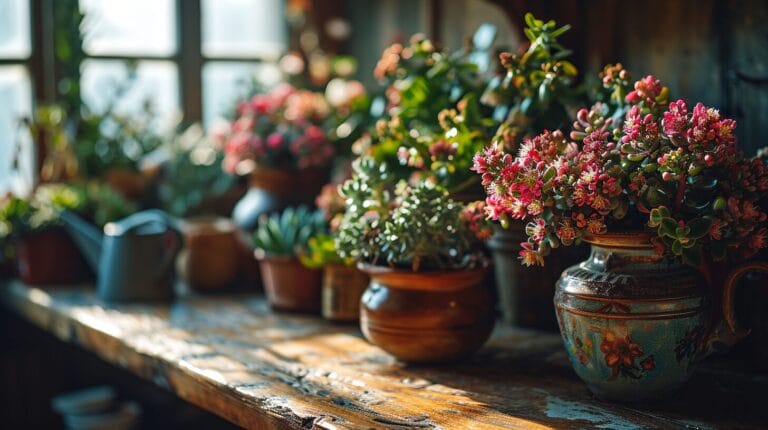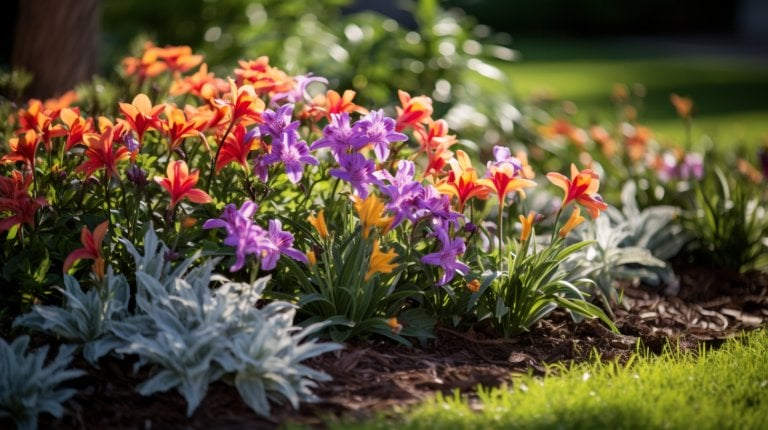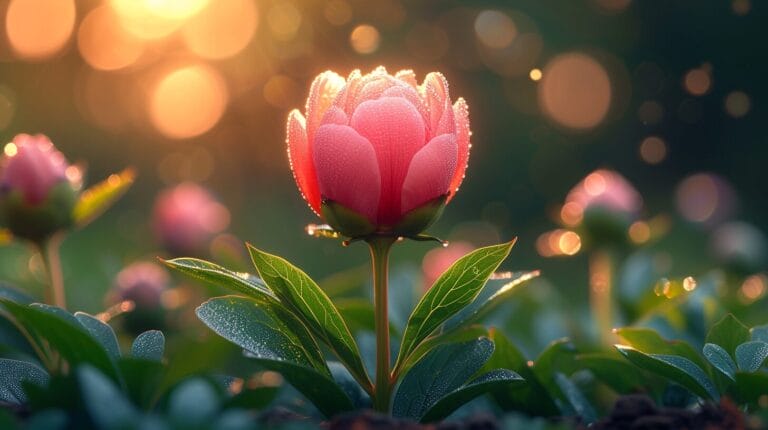White Flowering Trees in Spring: List of Trees with White Blooms
The captivating charm of trees blanketed with white blossoms in the spring, set amid a backdrop of radiant greenery, offers not only a visual feast, but also soothes the spirit. As avid gardeners, we frequently crave a touch of sophistication to perfect our personal sanctuaries in the open air.
Yet, in this pursuit, we might sometimes forget to appreciate the captivating simplicity and timeless beauty that white flowering trees bring. In embracing these gifts from Mother Nature, one finds that they weave together beauty with environmental stewardship seamlessly.
As we explore this tribute to nature’s delicate palette of whites further, you’ll encounter trees suited for all sorts of climates and settings—each waiting patiently to make a home in your yard or community space.
These majestic beings promise more than just looks; they’re poised to turn your area into an oasis teeming with birdsong and rustling leaves—a sanctuary where life thrives quietly beneath their watchful boughs. Stay tuned—your perfect, beautiful tree could very well be amongst this peaceful crowd, ready to whisper its stories through every season.
Key Takeaways
- White flowering trees add timeless beauty and elegance to any garden, contributing to the overall aesthetic appeal of outdoor spaces during spring.
- Trees like Kousa Dogwood, Cherry Blossoms, Magnolias, Fringe Trees, Serviceberry Trees, and Crab Apple trees are notable choices due to their unique features such as stunning white blooms, adaptability to various climates and soil conditions, low maintenance requirements, and their ability to attract wildlife.
- These trees not only offer visual delight but also contribute to environmental sustainability by supporting local ecosystems by attracting pollinators like bees and butterflies as well as providing food sources for birds or other wildlife.
- Each tree has its own distinct characteristics including fragrant spring flowers that fill the air with delightful scents in late spring or early summer.
The Charm of White Flowering Trees in Spring
White blooms in spring are like a fresh start. They make everything look clean and bright after winter. The flowers come out on trees when it’s still a bit cold, but the days are getting longer.
Trees with white flowers are really special because they seem to glow against the blue sky or green leaves.
These trees bloom early and fill the air with sweet smells. People love walking by them or looking at them through their windows. Birds and bees also like these trees because they can find food from the flowers.
White flowering trees make any place more pretty and alive in early spring.
Kousa Dogwood: A Springtime Favorite
Kousa Dogwood is a popular choice for springtime white florals, known for its striking appearance and abundant flowers. This small tree offers a stunning display of white petals in late spring, adding elegance to any garden landscape.
With its unique layered branches and vibrant foliage, Kousa Dogwood is a charming addition to any outdoor space.
Notable features of Kousa Dogwood
I love seeing my garden wake up in spring with white flowers. The Kousa Dogwood is a tree that stands out with its lovely blooms. Here are some things that make it special:
- In late spring, this tree comes alive with beautiful four – petaled white flowers.
- It fits well in small and big yards because it grows into a nice round shape.
- The Kousa Dogwood isn’t too picky. It does well in full sun or part shade.
- This tree doesn’t need a lot of care, so you can enjoy its beauty without too much work.
- Birds and bees like to visit the tree for its berry – like fruits after the flowers are gone.
- Those fruits look pretty in fall when many other trees have lost their leaves.
- With blooms sticking around for six weeks, this dogwood keeps your garden looking good for longer.
- It’s not too big or too small. This tree usually gets between 15 to 30 feet tall, so it fits right in.
Cherry Blossoms: Iconic Spring Beauty
The cherry blossoms, known for their spectacular show during spring, are a sight to behold with their delicate white florals adorning the trees in abundance. These iconic flowers have become synonymous with the beauty and elegance of the season, drawing admirers from all over the world to witness their stunning display.
Notable features of Cherry Blossoms
Cherry blossoms capture the heart of spring with their stunning display. Here’s what makes them so special:
- Delicate White Flowers: Come spring, cherry blossom trees put on a show with their beautiful white petals. Each flower is a sign that warmer days are here.
- Brief Blooming Period: These blooms don’t last long, usually just a few weeks. This short time makes their beauty feel even more precious.
- Symbol of Renewal: Seeing cherry blossoms can fill you with feelings of fresh starts and new beginnings. They remind us how quick life changes.
- Iconic Spring Beauty: Cherry blossoms are famous for turning landscapes into pink and white wonderlands. Their arrival is celebrated around the world as the true start of spring.
- Yoshino Cherry Trees: One kind of tree with these flowers is the Yoshino cherry tree. Its small, white florals gather in clusters, making it look like the branches are covered in fluffy white clouds.
- Fleeting Nature of Life: Because they bloom quickly and then are gone, these flowers make people think about how life is both beautiful and short.
- Gathering Spot for Communities: When cherry blossom trees flower in parks or along streets, they bring people together to enjoy this annual event.
Magnolias: Majestic White Flowers
The Magnolia tree is a classic choice for white spring blooms, with its elegant and majestic flowers adding a touch of timeless beauty to any garden. From the delicate Star Magnolia to the fragrant Sweetbay Magnolia, these trees are sure to captivate your senses and enhance your outdoor space.
Read on to discover why Magnolias are an essential addition to any garden this spring!
Notable features of Star Magnolia
I love watching my garden wake up in spring, especially when the Star Magnolia begins to bloom. Its white starburst flowers make it a standout among springtime trees.
- Starburst Blooms: One look and you’ll understand its name. This tree bursts into star-shaped flowers that are sure to catch any eye.
- Early Bloomer: It’s one of the first trees to flower in spring, sometimes even when there’s still a chill in the air.
- Perfect Size: With a height that can reach up to 20 feet, it fits well into most gardens without towering over other plants.
- Sun Lover: It loves soaking up the sun but also does well with a bit of afternoon shade.
- Fragrant Flowers: Not only beautiful, but its blooms also give off a lovely scent that adds another layer of enjoyment to your garden.
- Adaptable Roots: While it prefers moist, well-drained soil, this magnolia is quite adaptable and can handle different soil types.
- Minimal Upkeep: Once established, it doesn’t need much care. A little pruning after blooming keeps it healthy and looking good.
Notable features of Sweetbay Magnolia
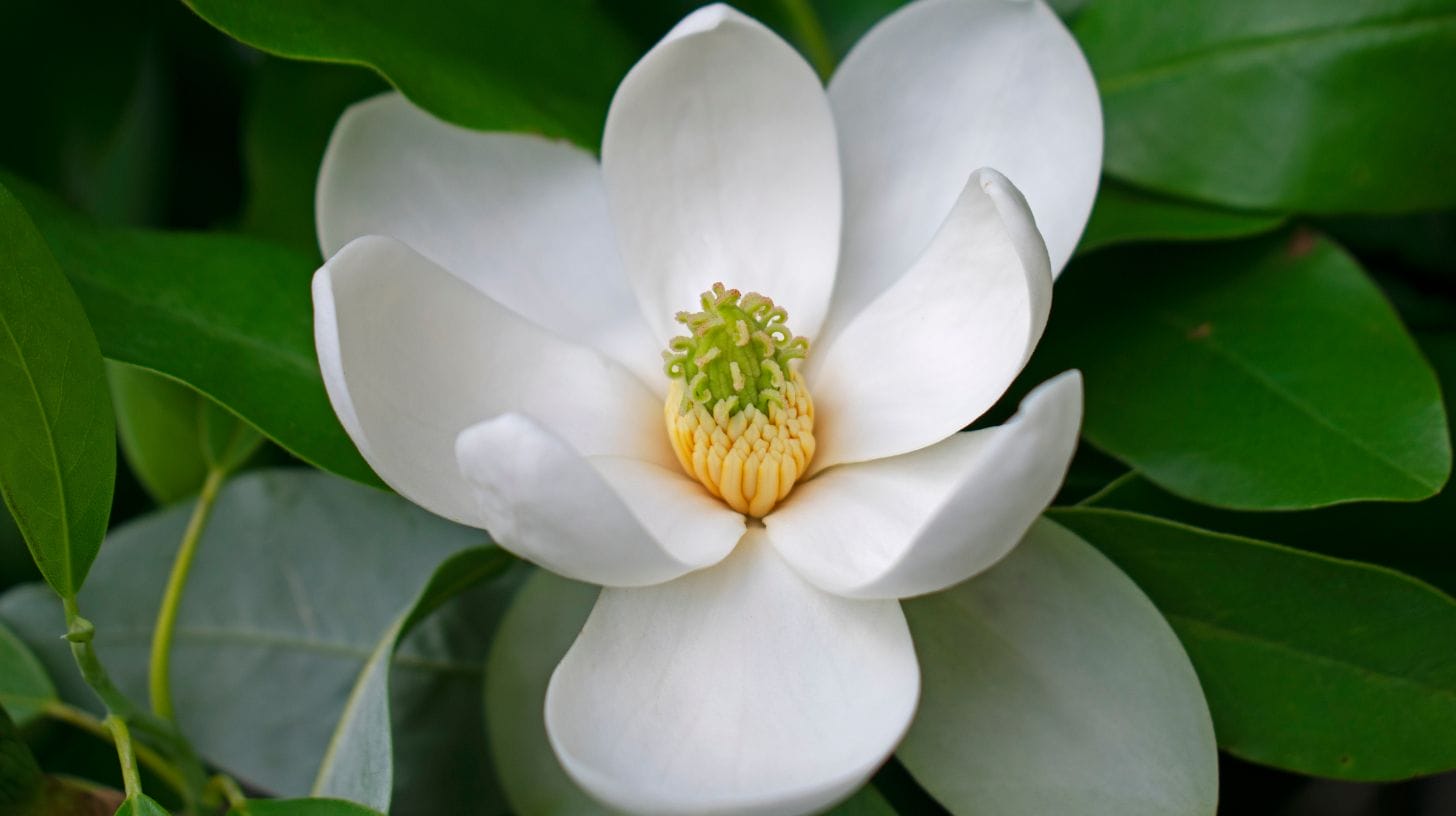
Sweetbay Magnolia, also known as Magnolia virginiana, is a versatile and low-maintenance tree that adds beauty and fragrance to any outdoor space. Its notable features include:
- Fragrant white flowers: The sweetly scented cream-white flowers of the Sweetbay Magnolia bloom in late spring or early summer, filling the air with a delightful aroma that attracts pollinators such as bees and other wildlife.
- Deep green leaves: The tree boasts lustrous, deep green leaves that provide an attractive backdrop for its elegant white petals.
- Symbol of the South: Sweetbay Magnolia is a symbol of the South and is cherished for its large, thick leaves and giant white flowers, making it a popular choice for gardeners looking to add a touch of southern charm to their landscapes.
- Low-maintenance: This tree is easy to care for and requires minimal maintenance once established, making it an excellent choice for sustainable gardening practices.
The Unique Fringe Tree
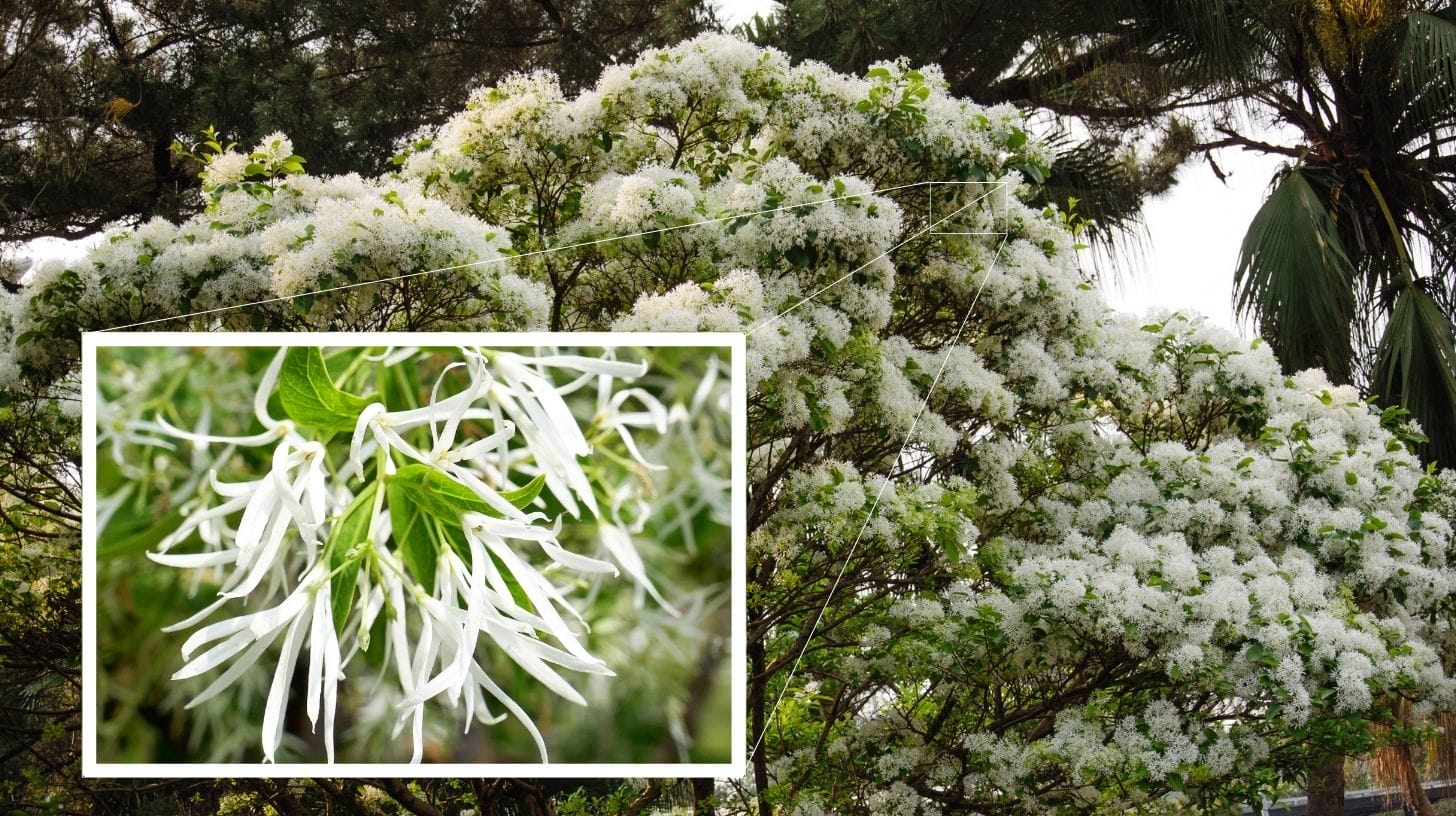
The Fringe Tree, valued for its unique and fragrant white flowers, adds a touch of elegance to any garden. Its delicate blooms are not only visually stunning but also give off a sweet, pleasant scent.
To learn more about this exceptional tree and how to incorporate it into your gardening plans, continue to read our blog for expert insights and tips on sustainable planting.
Notable features of the Fringe Tree
The Fringe Tree is low-maintenance and resistant to pests. It prefers full sun to part shade and well-drained soil. Known for its unique fringe-like flowers, the tree blooms from mid-summer to autumn. It is compact and slow-growing, ideal for small gardens. Additionally, it showcases striking yellow fall foliage and is native to the southeastern United States.
The Versatile Serviceberry Tree
The Serviceberry Tree, a remarkable addition to any garden, is renowned for its multi-season interest, beginning with its stunning display of white flowers in the spring. These delicate, star-shaped blossoms emerge in clusters, covering the tree in a blanket of pure white, creating a contrast against the awakening greenery.
As the season progresses, these flowers blooms and give way to succulent, deep-purple berries, which become a feast for both humans and local wildlife.
Notable features of Serviceberry
Serviceberry trees are compact and can reach up to 30 feet in height. They produce edible berries that are used in making jams, jellies, and pies. When fall arrives, the Serviceberry plants showcase striking foliage in vibrant shades of orange, red, and yellow.
Resistant to many pests and diseases, these trees are a low-maintenance addition to any garden. Their adaptability makes them suitable for a wide range of soil conditions. Additionally, they attract wildlife, especially birds with their abundant berries.
Are There Any White Flowering Trees with Negative Symbolism?
White flowering trees are often associated with purity, innocence, and elegance. However, it’s important to note that not all white flowers convey positive symbolism. Some white flowering trees, such as the Oleander, have flowers with negative symbolism. While their beauty is undeniable, these flowers symbolize caution and danger due to their toxic nature. Despite their negative connotations, white flowering trees overall offer an enchanting and serene presence in any landscape.
Crab Apple Trees: More Than Just Fruit
Crab Apple trees are not just valued for their delicious fruit, but also for their stunning springtime display of white flowers. These small to medium-sized trees produce clusters of small white flowers that cover the branches and add a beautiful touch to any garden or landscape.
In addition to providing visual appeal, these flowering trees attract pollinators like bees and butterflies, making them beneficial for local ecosystems. With their ornamental value and ecological benefits, Crab Apple trees are a wonderful addition to any sustainable garden.
Notable features of Crab Apple
I love Crab Apple trees for many reasons, and here are the notable features:
- Aesthetic Value: The beautiful white flowers of Crab Apple trees add elegance to any garden or outdoor space, creating a striking visual impact.
- Wildlife Attraction: These trees attract pollinators like bees and butterflies with their white blooms, contributing to the local ecosystem’s diversity.
- Edible Fruit: Crab Apple trees produce small, tart apples that are perfect for making jams, jellies, and preserves, adding a practical element to their appeal.
- Ornamental Value: Cherished for their ornamental value, these trees enhance landscapes with their clusters of white flowers, making them an excellent choice for landscaping projects.
- Compact Size: Despite reaching heights of up to 30 feet tall, the compact nature of Crab Apple trees makes them suitable for various outdoor spaces while still offering abundant white blossoms.
Conclusion: The Elegance of White in Your Garden
White flowering trees bring serene beauty to your landscape during spring. Consider adding these top trees to enhance your curb appeal. With their majestic white blossoms, they can elevate the charm of any garden.
Practical and efficient, these strategies are easy to implement for impressive results. Embrace the impact of these approaches and witness a transformation in your outdoor space. Let the elegance of white flowers enrich your garden with timeless beauty that captures the essence of spring.
Frequently Asked Questions
What kind of tree has white flowers in spring?
Trees like the dogwood, pear tree, and crabapple have beautiful white blooms in spring. They grow best when they get enough chill hours during winter.
Can you name some ornamental trees with white flowers that bloom early?
The magnolia, flowering cherries like the Japanese snowbell, and the Bradford pear are all ornamental trees that show off bright white flowers as soon as late winter or early spring.
Are there any evergreen trees that have white flowers in spring?
The Southern Magnolia is an evergreen tree known for its large white flowers that appear in late spring. It has green leaves all year and beautiful blooms when warm weather arrives.
Do any small deciduous trees produce clusters of small white flowers?
Small deciduous trees such as redbuds including the ‘White Redbud’ and ‘Royal White Redbud’, bloom with masses of small whites in early to mid-spring before their leaves come out.
I want a large tree with lots of big white blooms—what should I plant?
A good choice would be the catalpa speciosa or northern catalpa which grows into a large tree covered with many big, showy flower clusters after its dormant season ends.
Are dogwood trees different from other flowering trees?
Dogwoods like Cornus Florida (Florida Dogwood) and Cornus Kousa absolutely stand out because they offer layers of star-shaped blossoms during mid to late spring; also, birds love their red berries after flowers are gone.



